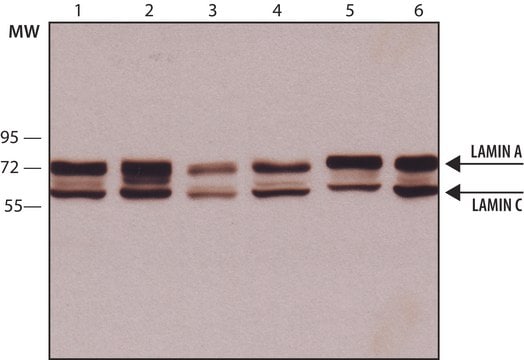MABT1341
Anti-Lamin A/C Antibody, clone 4C11
clone 4C11, from mouse
Synonym(e):
70 kDa Lamin, Renal carcinoma antigen NY-REN-32
About This Item
Empfohlene Produkte
Biologische Quelle
mouse
Antikörperform
purified immunoglobulin
Antikörper-Produkttyp
primary antibodies
Klon
4C11, monoclonal
Speziesreaktivität
human, monkey, Syrian hamster, rat, mouse
Verpackung
antibody small pack of 25 μg
Methode(n)
ChIP: suitable
immunofluorescence: suitable
immunoprecipitation (IP): suitable
western blot: suitable
Isotyp
IgG2aκ
NCBI-Hinterlegungsnummer
UniProt-Hinterlegungsnummer
Posttranslationale Modifikation Target
unmodified
Angaben zum Gen
human ... LMNA(4000)
Verwandte Kategorien
Allgemeine Beschreibung
Spezifität
Immunogen
Anwendung
Zellstruktur
Dot Blot Analysis: A representative lot detected Lamin A/C in Dot Blot applications (Roblek, M., et. al. (2010). PLoS One. 5(5):e10604).
Immunocytochemistry Analysis: A 1:1,000 dilution from a representative lot detected Lamin A/C in HeLa cells.
Western Blotting Analysis: A representative lot detected Lamin A/C in WB used to demonstrate high titration and excellent properties of clone 4C11 (Courtesy of Marie lang, M.D., Stefan Schuchner, Ph.D. and Egon Ogris, M.D., Medical University of Vienna, Austria).
Immunofluorescence Analysis: A representative lot detected the Lamin A/C species at the nuclear lamina of HeLa cells (Courtesy of Marie Lang, M.D., Stefan Schuchner, Ph.D. and Egon Ogris, M.D., Medical University of Vienna, Austria).
Immunoprecipitation Analysis: A representative lot detected Lamin A/C in WB used to demonstrate high titration and excellent properties of clone 4C11 (Courtesy of Marie Lang, M.D., Stefan Schuchner, Ph.D. and Egon Ogris, M.D., Medical University of Vienna, Austria).
Chromatin Immunoprecipitation (ChIP) Analysis: A representative lot detected Lamin A/C in Chromatin Immunoprecipitation applications (Gesson, K., et. al. (2016). Genome Res. 26(4):462-73).
Immunofluorescence Analysis: A representative lot detected Lamin A/C in Immunofluorescence applications (Roblek, M., et. al. (2010). PLoS One. 5(5):e10604).
Immunoprecipitation Analysis: A representative lot immunoprecipitated Lamin A/C in Immunoprecipitation applications (Gesson, K., et. al. (2016). Genome Res. 26(4):462-73).
Qualität
Western Blotting Analysis: 0.2 µg/mL of this antibody detected Lamin A/C in HeLa cell lysate.
Zielbeschreibung
Physikalische Form
Lagerung und Haltbarkeit
Sonstige Hinweise
Haftungsausschluss
Not finding the right product?
Try our Produkt-Auswahlhilfe.
Lagerklassenschlüssel
12 - Non Combustible Liquids
WGK
WGK 1
Flammpunkt (°F)
Not applicable
Flammpunkt (°C)
Not applicable
Analysenzertifikate (COA)
Suchen Sie nach Analysenzertifikate (COA), indem Sie die Lot-/Chargennummer des Produkts eingeben. Lot- und Chargennummern sind auf dem Produktetikett hinter den Wörtern ‘Lot’ oder ‘Batch’ (Lot oder Charge) zu finden.
Besitzen Sie dieses Produkt bereits?
In der Dokumentenbibliothek finden Sie die Dokumentation zu den Produkten, die Sie kürzlich erworben haben.
Unser Team von Wissenschaftlern verfügt über Erfahrung in allen Forschungsbereichen einschließlich Life Science, Materialwissenschaften, chemischer Synthese, Chromatographie, Analytik und vielen mehr..
Setzen Sie sich mit dem technischen Dienst in Verbindung.








